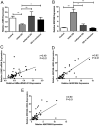lncRNA:mRNA expression profile in CD4+ T cells from patients with Graves' disease
- PMID: 33112836
- PMCID: PMC7774754
- DOI: 10.1530/EC-20-0373
lncRNA:mRNA expression profile in CD4+ T cells from patients with Graves' disease
Abstract
Graves' disease (GD) is a common autoimmune disease that affects the thyroid gland. As a new class of modulators of gene expression, long noncoding RNAs (lncRNAs) have been reported to play a vital role in immune functions and in the development of autoimmunity and autoimmune disease. The aim of this study is to identify lncRNAs in CD4+ T cells as potential biomarkers of GD. lncRNA and mRNA microarrays were performed to identify differentially expressed lncRNAs and mRNAs in GD CD4+ T cells compared with healthy control CD4+ T cells. Quantitative PCR (qPCR) was used to validate the results, and correlation analysis was used to analyze the relationship between these aberrantly expressed lncRNAs and clinical parameters. The microarray identified 164 lncRNAs and 93 mRNAs in GD CD4+ T cells differentially expressed compared to healthy control CD4+ T cells (fold change >2.0 and a P < 0.05). Further analysis consistently showed that the expression of HMlincRNA1474 (P < 0.01) and TCONS_00012608 (P < 0.01) was suppressed, while the expression of AK021954 (P < 0.01) and AB075506 (P < 0.01) was upregulated from initial GD patients. In addition, their expression levels were recovered in euthyroid GD patients and GD patients in remission. Moreover, these four aberrantly expressed lncRNAs were correlated with GD clinical parameters. Moreover, the areas under the ROC curve were 0.8046, 0.7579, 0.8115 for AK021954, AB075506, HMlincRNA1474, respectively. The present work revealed that differentially expressed lncRNAs were associated with GD, which might serve as novel biomarkers of GD and potential targets for GD treatment.
Keywords: CD4+ T cells; Graves’ disease; expression profile; lncRNA.
Figures





References
-
- Lichiardopol C, Mota M.The thyroid and autoimmunity. Romanian Journal of Internal Medicine 2009. 47 207–215. - PubMed
LinkOut - more resources
Full Text Sources
Research Materials

